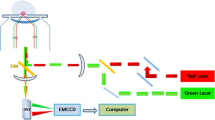Abstract
We examined the use of prism-type simultaneous dual-color total internal reflection fluorescence microscopy (TIRFM) to probe DNA molecules at the single-molecule level. The system allowed the direct detection of the complementary interactions between single-stranded probe DNA molecules (16-mer) and various lengths of single-stranded target DNA molecules (16-mer and 55-mer) that had been labeled with different fluorescent dyes (Cy3, Cy5, and fluorescein). The polymer-modified glass substrate and the extent of DNA probe immobilization were easily characterized either with standard TIRFM or with atomic force microscopy. However, only dual-color TIRFM could provide unambiguous images of individual single-stranded target DNA molecules hybridized with the correct sequence in the range of fM–aM. Succinic anhydride showed low RMS roughness and was found to be an optimal blocking reagent against non-specific adsorption, with an efficiency of 92%. This study provides a benchmark for directly monitoring the interactions and the detection of co-localization of two different DNA molecules and can be applied to the development of a nanoarray biochip at the single-molecule level.







Similar content being viewed by others
References
Liu Y, Ke Y, Yan H (2005) J Am Chem Soc 127:17140–17141
Mosher C, Lynch M, Nettikadan S, Henderson W, Kristmundsdottir A, Clark MW, Henderson E (2000) J Assoc Lab Automat 5:75–78
So H-M, Won K, Kim YH, Kim B-K, Ryu BH, Na PS, Kim H, Lee J-O (2005) J Am Chem Soc 127:11906–11907
Lee K-B, Lim J-H, Mirkin CA (2003) J Am Chem Soc 125:5588–5589
Lee K-B, Park S-J, Mirkin CA, Smith JC, Mrksich M (2002) Science 295:1702–1705
Lim J-H, Ginger DS, Lee K-B, Heo J, Nam J-M, Mirkin CA (2003) Angew Chem Int Ed 42:2309–2312
Piner RD, Zhu J, Xu F, Hong S, Mirkin CA (1999) Science 283:661–663
Ishijima A, Yanagida T (2001) Trends Biochem Sci 26:438–444
Sako Y, Yanagida T (2003) Nat Rev Mol Cell Biol Suppl SS1–SS5
Sako Y, Minoghchi S, Yanagida T (2000) Nat Cell Biol 2:168–172
Hibino K, Watanabe TM, Kozuka J, Iwane AH, Okada T, Kataoka T, Yanagida T, Sako Y (2003) Chemphyschem 4:748–753
Kang SH, Shortreed MR, Yeung ES (2001) Anal Chem 73:1091–1099
Jeong S, Park S-K, Chang JK, Kang SH (2005) Bull Korean Chem Soc 26:979–982
Funatsu T, Harada Y, Tokunaga M, Saito K, Yanagida T (1995) Nature 374:555–559
Xu X, Yeung ES (1997) Science 275:1106–1109
Xu X-H, Yeung ES (1998) Science 281:1650–1653
Murakoshi HR, Iino R, Kobayashi T, Fujiwara T, Ohshima C, Yoshimura A, Kusumi A (2004) Proc Natl Acad Sci (USA) 101:7317–7322
Ikuko K-H, Ken R, Takahiro F, Ryota I, Hideji M, Rinshi SK (2005) Biophys J 88:2126–2136
Schmoranzer J, Simon SM (2003) Mol Biol Cell 14:1558–1569
Liu S-F, Li Y-F, Li J-R, Jiang L (2005) Biosens Bioelectron 21:789–795
Itakura S-F, Rossi JJ, Wallace RB (1984) Annu Rev Biomed 53:323–356
Schena M, Shalon D, Davis RW, Brown PO (1995) Science 270:467–470
Eisen MB, Brown PO (1999) Meth Enzymol 303:179–205
Hegde P, Qi R, Abernathy K, Gay C, Dharap S, Gaspard R, Hughes JE, Snesrud E, Lee N, Quackenbush J (2000) Biotechniques 29:548–550
Diehl F, Grahlmann S, Beier M, Hoheisel JD (2001) Nucleic Acids Res 29:e38
Cheung VG, Morley M, Aguilar F, Massimi A, Kucherlapati R, Childs G (1999) Nat Genet 21:15–19
Duggan DJ, Bittner M, Chen Y, Meltzer P, Trent JM (1999) Nat Genet 21:10–14
Steel AB, Levicky RL, Herne TM, Tarlov MJ (2000) Biophys J 79:975–981
http://probes.invitrogen.com/lit/catalog/3/sections/1783.html
Acknowledgment
The authors wish to express their gratitude to Dr. B.-H. Chung at Korean Research Institute of Bioscience and Biotechnology (KRIBB) for his assistance with the Dual-View system. This work was supported by a grant from the Basic Research Program of the Korea Science & Engineering Foundation (R01-2004-000-10056-0).
Author information
Authors and Affiliations
Corresponding author
Rights and permissions
About this article
Cite this article
Kang, S.H., Kim, YJ. & Yeung, E.S. Detection of single-molecule DNA hybridization by using dual-color total internal reflection fluorescence microscopy. Anal Bioanal Chem 387, 2663–2671 (2007). https://doi.org/10.1007/s00216-007-1134-1
Received:
Revised:
Accepted:
Published:
Issue Date:
DOI: https://doi.org/10.1007/s00216-007-1134-1




